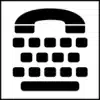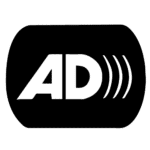Do you know about accessibility symbols like the audio description symbol, sign language interpretation symbol, telephone typewriter (TTY) symbol, or the information symbol? No? We cover everything you need to know about disabilities symbols here.
Keep reading and you just might find some interesting facts along the way…
In this article
Why do we need disability access symbols?
No matter what language you speak, what culture you belong to or where you live, it’s the idea that people everywhere are on the same page when it comes to interacting with and understanding symbols.
Even if you don’t know the local language, you’ll see a sign and know the floor is slippery just by looking at the symbol. That those substance is poisonous and so you should not come into contact with it. That you need to turn right or not go any further.
As a matter of fact, disabilities symbols are everywhere, allowing us to interact with our environment appropriately and making communicating easier for all.
For example – look carefully, and you’ll see one of these disabilities symbols all around you – the international symbol of access (ISA). This primary information symbol is used to label or provide direction to certain accessible spaces and elements, including parking spaces, entrances, toilet and bathing facilities, and public transport.
We’ll get into the nature and meanings of disabilities symbols soon…

About the international symbol of accessibility (ISA)
Some of the world’s most recognisable symbols are used to sell products, others to steer traffic or make a political statement. There’s one whose sole purpose is to help people – that’s the international symbol of accessibility. The ISA is one of the most widely recognised primary information symbols in the world.
Most people recognise the international symbol of accessibility as the image of a person in a wheelchair that’s usually set against a blue or white background. The symbol is meant to indicate that a certain area or facility – be it parking, seating, bathrooms, transport or something else – is accessible.
The three key functions of the symbol
- Informative – When the ISA is on display, you’ll know that suitable spaces for people with mobility challenges are provided. People like like wheelchair users, though they actually make up a relatively small percentage overall. Inside the building, directional and locational signage should show where these accessible areas are.
- Directional – A sign that says accessible amenities are available is one thing, but finding them can be hard without directional signage. A simple arrow showing a ramp’s location is useful, for example.
- Locational – It’s essential to use the ISA to find parking spaces and toilets, especially. The ISA is usually enough by itself, but you’ll notice the wording is usually short and to the point.
History of the ISA
In 1968, an organisation now called Rehabilitation International coordinated a design contest that led to the symbol’s creation. They were looking particularly for a disability symbol that was easily identifiable from a distance. Obviously the symbol needed to be self-descriptive, simple, practical and couldn’t be confused for any other existing signs.
The winning symbol design by Susanne Koefed was adopted by the 11th World Congress of Rehabilitation International in 1969. This led to it being on display all over the world to mark buildings and other spaces that are suitable for people living with disabilities.
So if you think about it, the adoption of the ISA proved how a simple design transformed the world for the better. Pretty impressive…
Is it time to update the accessibility symbol?
So here’s the other side of the ISA story. It wasn’t long after its implementation that the politics of disability became far more nuanced. At this point, people and organisations are questioning whether the ISA needs to be more inclusive.
One of these groups is the Accessible Icon Project. They updated the symbol in the hope that it will eventually replace the current ISA. See the updated version below:

What should an updated accessibility symbol signify (according to the Accessible Icon Project)?
- In this picture, the head is forward, indicating forward motion. Here, the person is the “driver” and makes decisions about their mobility.
- Regardless of whether the user uses their arms, there is a backward arm angle suggesting dynamic movement of a chair user. A body in motion symbolises the active status of navigating the world.
- With white angled knockouts, the wheel appears to be in motion.
- The human depiction in this symbol matches the body representations in other public information symbols (see ISO 7001 – DOT Pictograms).
- With the leg moved forward, there’s more space between it and the wheel, making it easier to read and apply the icon as a stencil.
Further movement on updating the accessibility symbol
Another group, McCann London (an advertising agency) thought the symbol needed to be updated to represent a broader range of disabilities, including invisible ones.
The issue was significantly important to a lot of McCann London employees who had family members with invisible disabilities and saw the hardships they went through, according to a 2018 interview with Design Week.
This is why the ad agency launched Visibility93 to rethink the ISA symbol and create a symbol for those with invisible disabilities, such as diabetes, arthritis, mental health conditions like schizophrenia, depression, and anxiety, and learning difficulties like dyspraxia. Even though this conversation happened a while back, it’s an example of how the politics of (dis)ability became far more inclusive and progressive.

More disability access symbols you should know about
These disabilities symbols promote and publicise the accessibility features of places, programmes and activities for people with disabilities…
Access to low vision symbol
Disabilities symbols like this one indicate access for people with partial or complete vision impairments. The access to low vision symbol is usually on display in museums and parks, for instance, to help people find their way to guided tours, a nature trail pathway, and exhibits.

Accessible print symbol (18 pt. or larger)
This disability symbol isn’t just for identifying large print books, pamphlets, museum guides, and theatre programs; it’s also used on conference and membership forms. This size of print is 18 pt. or larger and uses sans serif or modified serif font with high contrast. You’ll also notice the special attention paid to spacing of words and letters.

Telephone typewriter (TTY) symbol
There are a lot of names for this symbol, like Telephone Typewriter (TTY), Text Telephone (TT) and Telecommunication Device for the Deaf (TDD). This symbol points out a nearby device that can help people who are speech- or hearing-impaired communicate and interact more easily.

Audio description for TV, video and film symbol
For people with visual impairment, audio description enhances live performances, films and visual art. In audio description, the person receives a spoken description of visual elements via a small radio receiver.
Also, the audio description symbol means you can listen to audio commentary or narration of a visual production.
This is done by a trained audio describer, using headphones or a stereo. See the audio description for TV, video and film symbol below:

Sign language interpretation symbol
This indicates that sign language interpretation is available for a lecture, tour, film, performance, conference, or other event.

Sourced from www.disability-benefits-help.org
The information symbol
Information symbols are symbols that indicate a source of information, or they can be informative themselves. Some examples of information symbols are information boards and traffic signs. Some information symbols point to help desks (like in libraries, railway stations, and airports. And some information symbols act as indicators in reference books.
Additionally, the information symbol opens up other accessibility options, like large print texts, audio devices, recordings for visual interpretation, and guided tours.

Closed captioning (CC) symbol
Various performances, movies, TV shows, and online visuals will have captions. Captions will display on a screen during a performance, presentation, forum or film to help the audience read what the actors or presenters are saying.
Through subtitles or closed captions, which can often be turned on and off when watching via TV, viewers can read the proceedings through text captions. Even though the subtitles aren’t exactly verbatim, they get the message across.

Braille symbol
Written materials are available in Braille when the braille symbol is present. Publications, marketing materials and signage would all fall under this category.

Everything boils down to what our symbols try to accomplish…
A unified symbol must be able to tell one clear story worldwide. We should ask ourselves this question: should symbols evolve and incorporate elements of inclusivity or should symbols be a reflection of the past and remain in stasis?
More disability related information to consume
Looking for something just as interesting to read after this article? Here’s an interesting mix of blog posts to pique your curiosity or answer pressing questions you might’ve had…
- How to Be Considerate of Mobility Scooter Users While You’re Driving
- Mobility Scooter Safety is a Growing Issue
- Accessing the National Redress Scheme as Someone Living with Disability
- Are Electric Cars for Wheelchair Users a Reality or Not?
- Upcoming Changes to Income Support – An Increase That Won’t Go Far
Let us take care of you
All in all, the reason you clicked on this article is that you’re interested in the world we live in and on conversations about making it a better and more inclusive place. While you continue getting involved with this, let us take care of you and make your life better.
As a car and disability equipment insurance specialist, Blue Badge Insurance provides affordable, comprehensive wheelchair insurance and travel insurance for chair users. With this, your wheels are always protected whether you’re 1km or 10,000km away from home.
Did you know that if you’re a disability parking permit holder, you’re eligible for a discount on your disability car insurance premium with Blue Badge Insurance?
Click below to get a quote today.








